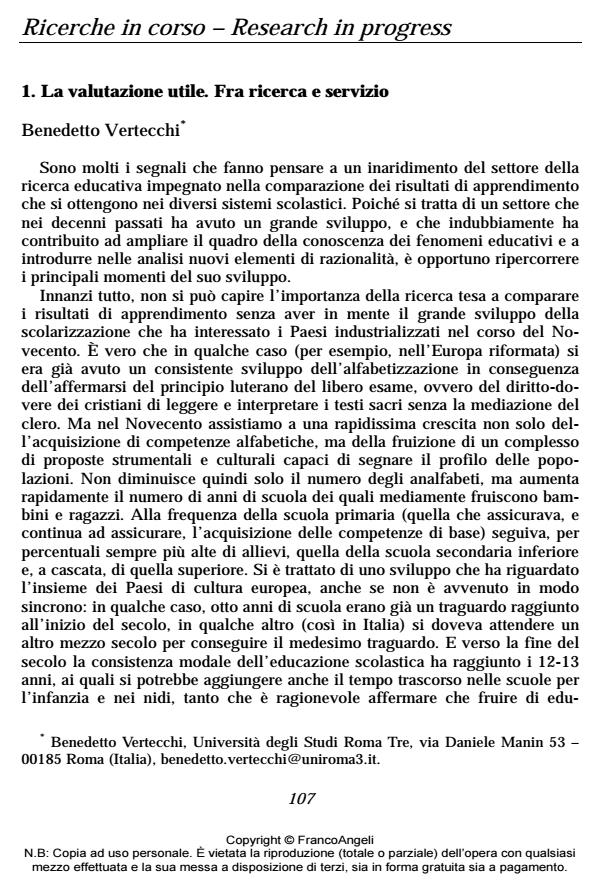Ricerche in corso - Research in progress
Titolo Rivista CADMO
Autori/Curatori A cura della Redazione
Anno di pubblicazione 2015 Fascicolo 2014/2 Lingua Italiano
Numero pagine 16 P. 107-122 Dimensione file 70 KB
DOI 10.3280/CAD2014-002010
Il DOI è il codice a barre della proprietà intellettuale: per saperne di più
clicca qui
Qui sotto puoi vedere in anteprima la prima pagina di questo articolo.
Se questo articolo ti interessa, lo puoi acquistare (e scaricare in formato pdf) seguendo le facili indicazioni per acquistare il download credit. Acquista Download Credits per scaricare questo Articolo in formato PDF

FrancoAngeli è membro della Publishers International Linking Association, Inc (PILA)associazione indipendente e non profit per facilitare (attraverso i servizi tecnologici implementati da CrossRef.org) l’accesso degli studiosi ai contenuti digitali nelle pubblicazioni professionali e scientifiche
- Berninger, V., Chanquoy, L. (2012), “What writing is and how it changes across early and Middle Childhood Development: A Multidisciplinary Perspective”, in E. Grigorenko, E. Mambrino, D. Preiss (eds), Writing: A Mosaic of Perspectives and Wiews. New York: Psychology Press, Ch. 5, pp. 65-84.
- Berninger, V.W., Abbott, R.D., Augsburger, A., Garcia, N. (2009), “Comparison of Pen and Keyboard Transcription Modes in Children with and without Learning Disabilities”, Learning Disability Quarterly, 32 (3), pp. 123-141.
- Gaggi, M. (2014), “La giostra inevitabile della tecnologia”, Corriere della Sera, 27 giugno.
- Graham, S. (2009), “Want to improve Children’s Writing? Don’t neglect Their Handwriting”, American Educator, Winter, http://www.scoe.org, u.a. 16/11/2014.
- Haas, C. (1996), Writing Technology: Studies on the Materiality of Literacy. Mahwah: Erlbaum Associates.
- James, K.H., Engelhardt, L. (2012), “The Effects of Handwriting Experience on Functional Brain Development in Pre-literate Children”, Trends in Neuroscience and Education, I, 1, pp. 32-42.
- James, K.H., Atwood, T.P. (2009), “The Role of Sensory Motor Learning in the Perception of Letter like Forms: Tracking the Causes of Neural Specialisation for Letters”, Cognitive Neuropsychology, 26, pp. 91-110.
- James, K.H., Gauthier, I. (2006), “Letter Processing automatically Recruits a Sensory Motor Brain Network”, Neuropsychology, 44, pp. 2937-2949.
- Mangen, A., Velay, J.L. (2010), “Digitizing Literacy: Reflections on the Haptics of Writing”, in M.H. Zadeh (ed), Advances of Haptics, http://www.intechopen.com/books/advances-in-haptics, pp. 385-402, u.a. 16/11/2014.
- Mueller, P.A., Oppenheimer, D. (2014), “The Pen is mightier than the Keyboard: Advantages of Longhand over Laptop Note Taking”, Psychological Science, 1-10, DOI: 10.1177/0956797614524581
- Spencer, L. (2012), “Does Cursive Handwriting need to be taught in a High Tech World?”, Chicago Tribune Local, 12 April, http://www.triblocal.com, u.a. 16/11/2014.
A cura della Redazione, Ricerche in corso - Research in progress in "CADMO" 2/2014, pp 107-122, DOI: 10.3280/CAD2014-002010